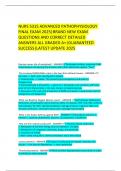NURS 5315 ADVANCED PATHOPHYSIOLOGY
FINAL EXAM 2025|BRAND NEW EXAM
QUESTIONS AND CORRECT DETAILED
ANSWERS ALL GRADED A+|GUARANTEED
SUCCESS|LATEST UPDATE 2025
Ovarian cancer site of metastasis? - ANSWER-✅Peritoneal surfaces, omentum (fold
of peritoneum connecting the stomach with other abdominal organs), *liver*
The increased NADH/NAD+ ratio in the liver from ethanol causes: - ANSWER-✅1.
Pyruvate --> lactic acid, causing lactic acidosis
2. Oxaloacetate --> malate. This prevents gluconeogenesis and leads to
hypoglycemia
3. Glyceraldehyde-3-phosphate --> glycerol 3- phosphate and combines with fatty
acids to form triglycerides in the liver, known as hepatosteatosis
4. Decreases citric acid cycle production of NADH and leads to using Acetyl-CoA for
ketogenesis and lipogenesis
What can Reactive Oxygen Species cause? - ANSWER-✅Heart disease, Alzheimers,
Parkinsons, Amyotrophic Lateral Sclerosis (ALS), CV disease, HTN, HLD, DM, ischemic
heart disease, HF, OSA. Lipid perioxidation, damage proteins, fragment DNA, less
*protein synthesis*, chromatin destruction, damage mitochondria
What is the body's defense against ROS? - ANSWER-✅Antioxidants (Vitamin E,
Vitamin C, cysteine, glutathione, albumin, ceruloplasmin, transferrin)
How are free radicals produced? - ANSWER-✅1. Normal cellular respiration
2. Absorption of extreme energy sources (radiation, UV light)
3. Metabolism of exogenous chemicals, drugs, and pesticides
4. Transition of metals
5. Nitric oxide acting like a chemical mediator and a free radical
action potential - ANSWER-✅Process of conducting an impulse. Activates the
neuron --> the neuron depolarizes --> then repolarizes
Threshold potential - ANSWER-✅Point at which depolarization must reach in order
to initiate an action potential
, Hypokalemia and action potentials - ANSWER-✅HYPERpolarized (more negative, ex.
-100). Less excitable. Decreased neuromuscular excitability: weakness, smooth
muscle atony, paresthesia, cardiac dysrhythmias
Hyperkalemia and action potentials - ANSWER-✅HYPOpolarized (more positive, ex:
closer to 0). More excitable. Peaked T waves.
When resting membrane potential=threshold potential, it is BAD = cardiac standstill,
paresthesia, paralysis
Hypocalcemia and action potentials - ANSWER-✅Increased permeability to Na+.
More excitable. Tetany, hyperreflexia, circumoral paresthesia, seizures,
dysrhythmias.
Hypercalcemia and action potentials - ANSWER-✅Decreased permeability to Na+.
Less excitable. Weakness, hyporeflexia, fatigue, lethargy, confusion, encephalopathy,
depressed T waves
Atrophy - ANSWER-✅Occurs as a result of decrease in work load, pressure, use,
blood supply, nutrition, hormonal stimulation, or nervous stimulation. Once the cell
has decreased in size, it has now compensated for decreased blood supply, nerve
supply, nutrient supply, hormonal supply, and has achieved new homeostasis. Cells
are alive but have diminished function and may lead to cellular death.
Atrophy examples - ANSWER-✅Physiologic atrophy- shrinking of the thymus gland
during childhood.
Disuse atrophy- someone that ends up being paralyzed
Hypertrophy - ANSWER-✅Increase in SIZE of cells, which will lead to increase in size
of organ. Caused by hormonal stimulation or increased functional demand.
Hypertrophy examples - ANSWER-✅physiologic hypertrophy- skeletal hypertrophy
when a person does heavy work or weight lifting / when a kidney is surgically
removed, the other kidney increases in size
pathologic hypertrophy- cardiomegaly results from an increased workload in
hypertensive patients / *left ventricular hypertrophy*
Hyperplasia - ANSWER-✅Increase in NUMBER of cells. Results from increased rate
of mitosis. Can ONLY happen in cells that are capable of mitosis (cell division).
Hyperplasia examples - ANSWER-✅1. Thickening of skin because of hyperplasia of
epidermal cells.
2. Hormonal hyperplasia- occurs in estrogen dependent organs like uterus and
breast.
3. Compensatory hyperplasia- liver regenerates, callus on skin
4. Pathologic hyperplasia- estrogen is unopposed by progesterone and the
endometrial lining undergoes hyperplasia and increased risk for endometrial cancer
, Dysplasia - ANSWER-✅abnormal changes in the size, shape, and organization of
mature cells due to persistent, severe cell injury or irritation
Dysplasia examples - ANSWER-✅Pre cancer pap smears often show dysplastic cells
of the cervix that must undergo treatment.
Metaplasia - ANSWER-✅Changed cell that is REVERSIBLE (one cell is replaced by
another cell). Exposure to chronic stressors, injury or irritation, like smoking or
hydrochloric acid from heart burn
Metaplasia examples - ANSWER-✅Most common is change from columnar cells to
squamous cells (chronic smokers).
Less common is change from squamous to columnar cells, like in Barrett Esophagus
caused by heart burn.
Carcinoma in situ - ANSWER-✅Pre-invasive epithelial malignant tumors of glandular
or squamous origin. Sites including cervix, skin, oral cavity, esophagus, and bronchus
Hypoxic injury - ANSWER-✅1. Decrease in oxygen in the air (high altitudes,
asphyxiation, drowning)
2. Loss of hemoglobin function (hemorrhage or sickle cell anemia)
3. Decrease in production of red blood cells (anemia or leukemia)
4. Diseases of cardiopulmonary systems (ischemia, blood supply loss, arteriosclerosis)
Hypoxic injury clinical manifestations - ANSWER-✅1. Increased CK (muscle and
heart)
2. Increased LDH (muscle, liver, lung, heart, RBC, brain)
3. Increased ALT and AST (liver)
4. Increased troponin (heart)
Reperfusion injury - ANSWER-✅Oxygen supply is restored to ischemic tissues.
Triggers oxygen intermediates which causes cell membrane damage and
mitochondrial calcium overload.
Xanthine dehydrogenase --> xanthine oxidate. This makes large amounts of free
radicals, superoxide, and hydrogen peroxide. Causes cell membrane damage and
*mitochondrial calcium overload*
Reperfusion injury clinical manifestations - ANSWER-✅White blood cell count is
impaired. Seen in tissue transplantation, ischemic syndromes of the heart, liver,
intestines, kidneys, and cerebrum.
Free Radical - ANSWER-✅Molecules that have an unpaired electron on its outer
shell. This makes the molecule unstable.
Cause cellular injury, aging, and disease to occur.




